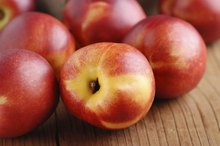What does fact checked mean?
At Healthfully, we strive to deliver objective content that is accurate and up-to-date. Our team periodically reviews articles in order to ensure content quality. The sources cited below consist of evidence from peer-reviewed journals, prominent medical organizations, academic associations, and government data.
- MedlinePlus: Hypotonia
- National Heart, Lung and Blood Institute: Balance Food and Activity
- National Heart, Lung and Blood Institute: Balance Food and Activity
The information contained on this site is for informational purposes only, and should not be used as a substitute for the advice of a professional health care provider. Please check with the appropriate physician regarding health questions and concerns. Although we strive to deliver accurate and up-to-date information, no guarantee to that effect is made.
Nutrition for Children With Low Muscle Tone
Lower muscle tone, also known as hypotonia, sometimes occurs in children 4. The cause of low muscle tone in kids varies widely, but it includes brain damage, muscle disorders and other genetic or chromosomal disorders, according to MedlinePlus 1. Some kids just naturally have lower muscle tone than others. Unless your child with low muscle tone also has a genetic disorder that requires a special diet, however, nutrition requirements are the same as kids with higher muscle tone.
Caloric Recommendations
Children with low muscle tone have similar caloric requirements as other children. But because they have less muscle mass, they may need slightly fewer calories than children with higher muscle tone, depending on their activity level.
Fruits, Vegetables and Grains
What Is an Isocaloric Diet?
Learn More
Kids with low muscle tone should get plenty of fruits, veggies and grains every day. Choose whole grains when possible. One ounce from the grains group equals 1/2 cup of oatmeal, one slice of whole-grain bread, 1 cup of whole-grain breakfast cereal or 1/2 cup of quinoa, brown rice or whole-grain pasta.
Protein and Dairy Foods
Because regular exercise is important for children with low muscle tone, getting plenty of protein -- including dairy foods -- is a must. Kids who eat 1,600 calories need 3 cups of dairy foods and 5 ounces from the protein foods group daily, notes the "Dietary Guidelines for Americans, 2010." Healthy, protein-rich foods include:
- lean meats
- eggs
- poultry
- legumes
- soy products
- nuts
- seeds
- low-fat milk
- yogurt
- cheese
Improving Muscle Tone
Government Guidelines on Healthy Eating & Nutrition for Children
Learn More
While it’s important to chat with your child’s pediatrician before encouraging a child with low muscle tone to become more physically active, exercise is often effective at increasing muscle mass and tone in these children. Boston Children’s Hospital suggests that regular physical therapy is often beneficial for kids with low muscle tone 4. The "2008 Physical Activity Guidelines for Americans" recommends kids get at least one hour of physical activity daily -- this includes children with low muscle tone, unless a pediatrician suggests otherwise 5.
Related Articles
References
- MedlinePlus: Hypotonia
- National Heart, Lung and Blood Institute: Balance Food and Activity
- U.S. Department of Agriculture, U.S. Department of Health and Human Services: Dietary Guidelines for Americans, 2010
- Boston Children’s Hospital: Muscle Weakness (Hypotonia)
- U.S. Department of Health and Human Services: 2008 Physical Activity Guidelines for Americans Summary
Writer Bio
Erin Coleman is a registered and licensed dietitian. She also holds a Bachelor of Science in dietetics and has extensive experience working as a health writer and health educator. Her articles are published on various health, nutrition and fitness websites.









